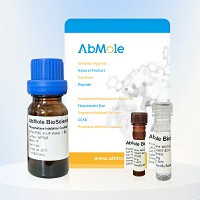All AbMole products are for research use only, cannot be used for human consumption.

Mouse RANKL/TNFSF11 is a member of the tumor necrosis factor (TNF) cytokine family. Tnfsf11 is widely expressed in cells, including T cells, and in T cell-rich organs, such as the thymus and lymph nodes. This cytokine can bind to TNFRSF11B/OPG and TNFRSF11A /RANK. Tnfsf11 is involved in many fundamental biological processes, such as acting as a regulator of interactions between T cells and dendritic cells, regulating T cell-dependent immune responses and enhancing bone resorption in malignant humoral hypercalcemia. It enhances the ability of dendritic cells to stimulate the proliferation of naive T cells.
Loaded Recombinant Human OPG-Fc on Pro A Biosensor, can bind Mouse RANKL-His(M15095) with an affinity constant of 1.02 pM as determined in BLI assay.
Accession: BAA97257.1
APMol Mass: 30-35 KDa, reducing conditions
Endotoxin <1 EU/µg
Lyophilized from a 0.2 μm filtered solution of 20mM Hepes-NaOH, 50mM NaCl, 6% Trehalose, 4% Mannitol, 0.05% Tween 80, pH 8.0.
| Form | Lyophilized powder |
| Solubility (25°C) | Reconstitute the lyophilized powder in distilled water up to 100 μg/ml. |
| Storage | Stored at ≤ -20°C, stable for one year after receipt. Reconstituted protein solution can be stored at 2-8°C for 2-7 days and at -20°C for 3 months. |
| Related Cytokines and Growth Factors Products |
|---|
| Recombinant Human GDF-15 Protein (HEK293 N-hFc)
Growth-differentiation factor 15 (GDF15), also known as MIC-1, is a secreted member of the transforming growth factor (TGF)-β superfamily. GDF-15 has a role in regulating inflammatory and apoptotic pathways in injured tissues and during disease processes. GDF-15 overexpression arising from an expanded erythroid compartment contributes to iron overload in thalassemia syndromes by inhibiting hepcidin expression. |
| Recombinant Human FGFR1 Protein (HEK293, C-His)
FGFR1, also known as CD331, is a full-length representative protein consists of an extracellular region, composed of three immunoglobulin-like domains, a single hydrophobic membrane-spanning segment and a cytoplasmic tyrosine kinase domain. |
| Recombinant Human FGFR2 Protein (HEK293, C-His)
FGFR2, also known as CD332, acts as cell-surface receptor for fibroblast growth factors and plays an essential role in the regulation of cell proliferation, differentiation, migration and apoptosis, and in the regulation of embryonic development. FGFR2 plays an essential role in the regulation of osteoblast differentiation, proliferation and apoptosis, and is required for normal skeleton development. It also promotes cell proliferation in keratinocytes and imature osteoblasts, but promotes apoptosis in differentiated osteoblasts. |
| Recombinant Mouse BMP-4 Protein (E. coli, C-His)
Bone Morphogenetic Protein-4 (BMP-4) is a critical signaling molecule required for the early differentiation of the embryo and establishing of a dorsal-ventral axis. BMP-4 is secreted from the dorsal portion of the notochord, and it acts in concert with sonic hedgehog to establish a dorsal-ventral axis for the differentiation of later structures. |
| Recombinant Human Coagulation Factor X (HEK293, C-Fc)
Coagulation factor X, belongs to the peptidase S1 family. Coagulation factor X is initially synthesized in the liver. Coagulation factor X is a vitamin K-dependent glycoprotein that converts prothrombin to thrombin in the presence of factor Va, calcium and phospholipid during blood clotting. |
All AbMole products are for research use only, cannot be used for human consumption or veterinary use. We do not provide products or services to individuals. Please comply with the intended use and do not use AbMole products for any other purpose.


Products are for research use only. Not for human use. We do not sell to patients.
© Copyright 2010-2024 AbMole BioScience. All Rights Reserved.
